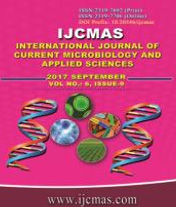


 National Academy of Agricultural Sciences (NAAS)
National Academy of Agricultural Sciences (NAAS)

|
PRINT ISSN : 2319-7692
Online ISSN : 2319-7706 Issues : 12 per year Publisher : Excellent Publishers Email : editorijcmas@gmail.com / submit@ijcmas.com Editor-in-chief: Dr.M.Prakash Index Copernicus ICV 2018: 95.39 NAAS RATING 2020: 5.38 |
Phenotypic and genotypic diversity of rhizobia isolated from root and soil rhizosphere of summer mungbean was assessed on the basis of plant growth promoting traits and using RAPD primers. In present studies, isolates of rhizobia from nodules were purified on Congo red Yeast Mannitol Agar (CRYEMA) medium from summer mungbean growing areas of Punjab state, India. Slow and fast growing colonies of rhizobial isolates were selected on Bromo Thymol Blue (BTB) supplemented with YEMA medium. Among five RAPD primers used in present study, two of the primers RAPD-4 and RAPD-5 showed maximum number of detectable bands. Highest polymorphism detected with RAPD-5 during PCR amplification. Cluster analysis divided rhizobial isolates into five distinct groups. The data depicts that although the growth promoting parameter i.e. Indole acetic acid (IAA) production, phosphate solubilization were very promising in LSMR-1, LSMR-5, LSMR-8, LSMR-9, LSMR-19 and LSMR-23 but they were genetically diverse and fall under different groups of cluster analysis. Whereas, LSMR-1 and LSMR-5 showed a very close relation isolated from same native rhizosphere. The assessment of genetic diversity is a prerequisite and important step for the improvement of any legume crop. It is concluded that significant genetic diversity in rhizobial strains exists with respect to their efficiency for IAA production and P-solubilization.
 |
 |
 |
 |
 |